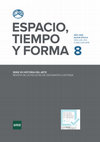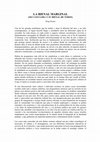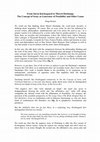Papers by Diego Renart González

ESPACIO, TIEMPO Y FORMA SERIE VII HISTORIA DEL ARTE REVISTA DE LA FACULTAD DE GEOGRAFÍA E HISTORIA, 2020
En la República Dominicana las formas e ideas artísticas contemporáneas tuvieron que esperar tant... more En la República Dominicana las formas e ideas artísticas contemporáneas tuvieron que esperar tanto al arribo de los refugiados europeos tras los devastadores conflictos mundiales de finales de los años treinta, como a las idas y venidas de algunos artistas dominicanos para ser asimiladas. Sin duda, un proceso de asimilación tardía que produjo un carácter endémico singular en su medio cultural. Así, dentro de una de las dictaduras más terribles que ha soportado América, la evolución del arte corrió paralela a los sucesos políticos y sociales más trágicos, orientándose, a grandes rasgos, de dos maneras diferentes: por un lado, a través de la vía puramente estética, la que al parecer desembocó en la abstracción (de la que creemos se acierta por vez primera su origen); por otro, de la simbólica, la que acogiéndose a la tradicional figuración empleó herramientas de insubordinación y de protesta como sutil desahogo. Asimismo, a pesar de prolongarse el trujillato hasta 1961, fecha del tiranicidio, acotamos la franja temporal de estudio por motivos de extensión.
Abstract
Contemporary artistic forms and ideas had to wait in the Dominican Republic both up to the arrival of the European refugees after the devastating global conflicts in the late thirties as well as to the return of some Dominican artists to be assimilated. Without a doubt, this process of late assimilation produced a regional and special characteristic in its cultural environment. In this way, within one of the most dreadful dictatorships borne in America, the evolution of art ran in parallel to the most tragic political and social events, orienting itself, in general, in two different ways: on the one hand, through the purely aesthetic one, that apparently ended in abstraction (from which moreover we think its origin is guessed for the first time); on the other hand, through the symbolic one, the one that via traditional figurative art used insubordination and protest tools as a subtle relief. Additionally, in spite of being extended the Trujillato until 1961, the date of the tyrannicide, we delimit the chronology of the study because of the extension of the text.

ONTO, 2018
Uno de los grandes problemas que ha tenido y tiene la difusión del arte, y no sólo contemporáneo,... more Uno de los grandes problemas que ha tenido y tiene la difusión del arte, y no sólo contemporáneo, es lograr hacerlo llegar y extenderlo entre las diferentes capas de la sociedad. En cada museo, en cada centro o espacio cultural, encontramos servicios o departamentos encargados de difundir sus colecciones y piezas con el fin de transmitir el mensaje y las cualidades formales interrelacionadas de una obra de arte u objeto en exposición. Esta facilitación que hoy es fundamental, un servicio público inalienable que protege nuestro derecho de acceso a la cultura desde las instituciones, ha sido durante años el tema de debate desde unos parámetros determinados, convencionales y homogeneizadores, que, por lo demás, no sirven o no dan solución, ni siquiera desde la cooperación internacional, a la tarea que tienen por delante los países con un sistema educativo insuficiente y en perpetua vía de subdesarrollo material.

Ars Bilduma, Departamento de Historia del Arte y Música de la Facultad de Letras (Vitoria-Gasteiz) de la Universidad del País Vasco UPV/EHU , 2017
La vida-obra de Marcel Duchamp es factible gracias a la posibilidad, a su expansión. Como artista... more La vida-obra de Marcel Duchamp es factible gracias a la posibilidad, a su expansión. Como artista clandestino conciliador de opuestos, amplía la cotidianidad a través de la imaginación, de la ironía, incorporando en objetos de arte obsesiones de nuestro permanente interés. Una de ellas es la erótica, y al igual que en el ámbito de la ironía, Sören Kierkegaard y el Diario de un Seductor se convierten aquí en cómplices para configurar una secuencia plástica de incierto precedente visual, que será la clave, sin embargo, para el desarrollo de su futura expresión.
Marcel Duchamp's life's work is feasible thanks to the possibility, to its expansion. As an underground, conciliatory of opposites artst, amplifes daily life through imaginaton or irony incorporatng in art objects obsessions of our permanent interest. One of them is erotc, and just as in the feld of irony, Sören Kierkegaard and his Diary of a Seducer become here accomplices to confgure a plastc sequence of uncertain visual precedent that will be, however, the key for the development of his next expression.
La vie-ouvrage de Marcel Duchamp est faisable grâce à la possibilité, à son expansion. Comme artste clandestn conciliateur d’opposés, il agrandit la quotdienneté à travers de l’imaginaton, de l’ironie, en incorporant dans des objets d’art des obsessions qui sont de notre intérêt permanent. Une d’elles est l’erotque, et dans le même sens que l’ironie, Sören Kierkegaard et Le Journal du Séducteur se transforment ici en complices pour former une séquence plastque d'une incertaine provenance visuel, qui sera la clef, sans doute, pour une future projecton expressive.
Talks by Diego Renart González
Mapping South-South Connections: Networks, Alliances and New Actors on the International Scene during the Decolonization Process and Cold War in Latin America, Asia and Africa (1810-1990), Allameh Tabataba'i University (Tehran) and Universidad Autónoma de Madrid, 2020
I would like to introduce, within the topic that brings us together, a Dominican artist almost un... more I would like to introduce, within the topic that brings us together, a Dominican artist almost unknown today called Silvano Lora , in order to discover and to explore the activity of a committed actor which helps us to understand and to go in depht in the study of the relationships between visual art and a revolutionary time: the decolonisation process and Cold War in Latin America, Asia and Africa.

Living in Uncertainty: Kierkegaard and Possibility, Institute of Modern Languages Research, School of Advanced Study, University of London , 2019
We could say that thinking about Marcel Duchamp, the ready-made inventor, is thinking about origi... more We could say that thinking about Marcel Duchamp, the ready-made inventor, is thinking about originality. Of course. But, as every artist, he also has influences by several writers, philosophers, mathematicians and even artists (he used to say: "as a painter I prefer to be influenced by a writer rather than by another painter"): so, among them, there are peculiar and extraordinary writers like Alfred Jarry, Isidore Ducasse, Jules Laforgue or Raymond Roussell; scientists such as Henri Poincaré or Pawloski; artists, as for example, Leonardo da Vinci, Francis Picabia, cubists and futurists at some point; and philosophers such as Max Stirner, Henri Bergson, Paul Lafargue as well as one that usually is not in relation with the artist: Søren Kierkegaard.











Uploads
Papers by Diego Renart González
Abstract
Contemporary artistic forms and ideas had to wait in the Dominican Republic both up to the arrival of the European refugees after the devastating global conflicts in the late thirties as well as to the return of some Dominican artists to be assimilated. Without a doubt, this process of late assimilation produced a regional and special characteristic in its cultural environment. In this way, within one of the most dreadful dictatorships borne in America, the evolution of art ran in parallel to the most tragic political and social events, orienting itself, in general, in two different ways: on the one hand, through the purely aesthetic one, that apparently ended in abstraction (from which moreover we think its origin is guessed for the first time); on the other hand, through the symbolic one, the one that via traditional figurative art used insubordination and protest tools as a subtle relief. Additionally, in spite of being extended the Trujillato until 1961, the date of the tyrannicide, we delimit the chronology of the study because of the extension of the text.
Marcel Duchamp's life's work is feasible thanks to the possibility, to its expansion. As an underground, conciliatory of opposites artst, amplifes daily life through imaginaton or irony incorporatng in art objects obsessions of our permanent interest. One of them is erotc, and just as in the feld of irony, Sören Kierkegaard and his Diary of a Seducer become here accomplices to confgure a plastc sequence of uncertain visual precedent that will be, however, the key for the development of his next expression.
La vie-ouvrage de Marcel Duchamp est faisable grâce à la possibilité, à son expansion. Comme artste clandestn conciliateur d’opposés, il agrandit la quotdienneté à travers de l’imaginaton, de l’ironie, en incorporant dans des objets d’art des obsessions qui sont de notre intérêt permanent. Une d’elles est l’erotque, et dans le même sens que l’ironie, Sören Kierkegaard et Le Journal du Séducteur se transforment ici en complices pour former une séquence plastque d'une incertaine provenance visuel, qui sera la clef, sans doute, pour une future projecton expressive.
Talks by Diego Renart González
Abstract
Contemporary artistic forms and ideas had to wait in the Dominican Republic both up to the arrival of the European refugees after the devastating global conflicts in the late thirties as well as to the return of some Dominican artists to be assimilated. Without a doubt, this process of late assimilation produced a regional and special characteristic in its cultural environment. In this way, within one of the most dreadful dictatorships borne in America, the evolution of art ran in parallel to the most tragic political and social events, orienting itself, in general, in two different ways: on the one hand, through the purely aesthetic one, that apparently ended in abstraction (from which moreover we think its origin is guessed for the first time); on the other hand, through the symbolic one, the one that via traditional figurative art used insubordination and protest tools as a subtle relief. Additionally, in spite of being extended the Trujillato until 1961, the date of the tyrannicide, we delimit the chronology of the study because of the extension of the text.
Marcel Duchamp's life's work is feasible thanks to the possibility, to its expansion. As an underground, conciliatory of opposites artst, amplifes daily life through imaginaton or irony incorporatng in art objects obsessions of our permanent interest. One of them is erotc, and just as in the feld of irony, Sören Kierkegaard and his Diary of a Seducer become here accomplices to confgure a plastc sequence of uncertain visual precedent that will be, however, the key for the development of his next expression.
La vie-ouvrage de Marcel Duchamp est faisable grâce à la possibilité, à son expansion. Comme artste clandestn conciliateur d’opposés, il agrandit la quotdienneté à travers de l’imaginaton, de l’ironie, en incorporant dans des objets d’art des obsessions qui sont de notre intérêt permanent. Une d’elles est l’erotque, et dans le même sens que l’ironie, Sören Kierkegaard et Le Journal du Séducteur se transforment ici en complices pour former une séquence plastque d'une incertaine provenance visuel, qui sera la clef, sans doute, pour une future projecton expressive.